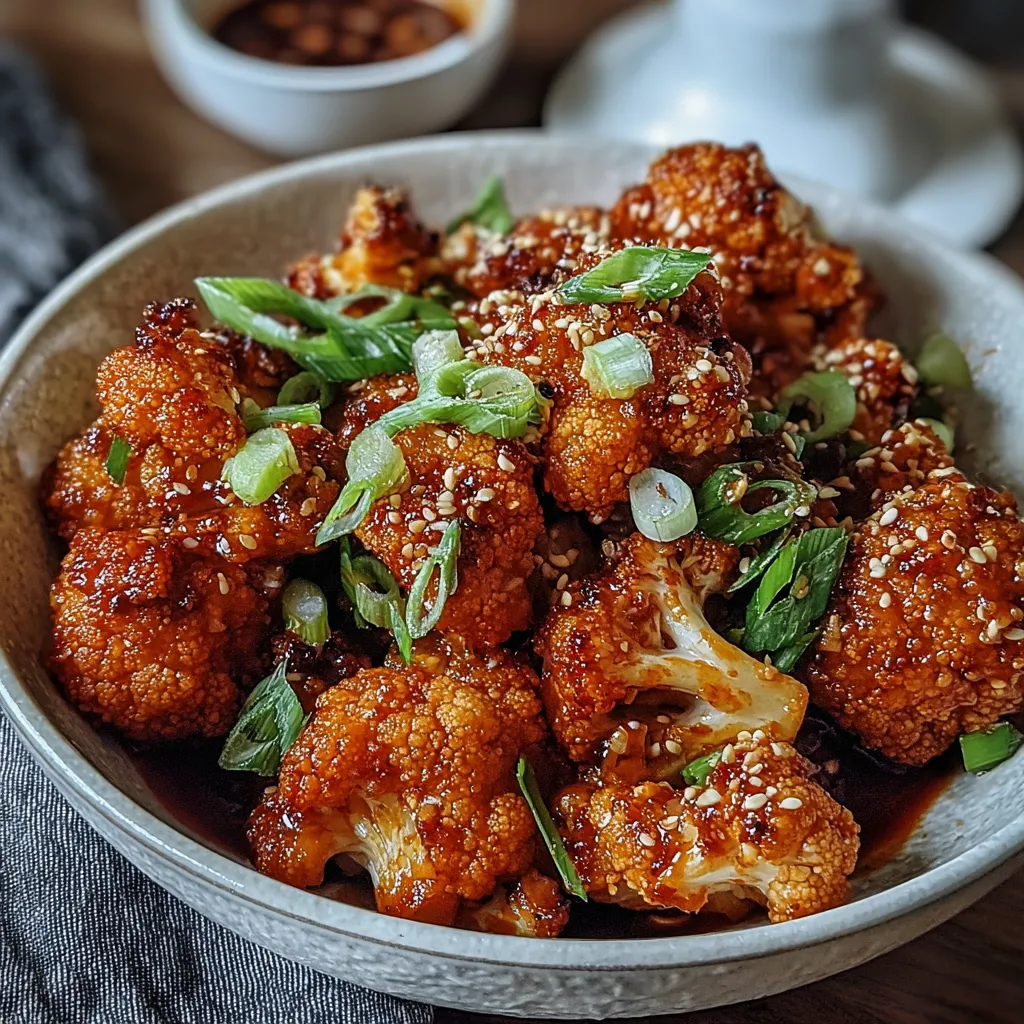 Save
Save
This Korean Baked Cauliflower transforms humble florets into an explosion of flavors that perfectly balance spicy, sweet, and savory notes. The crispy edges of roasted cauliflower coated in a glossy, vibrant gochujang sauce create a dish that satisfies like takeout but feels virtuous enough for weeknight dinners.
I first made this dish when trying to recreate my favorite Korean restaurant appetizer, and it's become my go to recipe for introducing friends to Korean flavors. The way the cauliflower caramelizes with that sticky sauce converts even the most dedicated meat eaters.
Ingredients
- Cauliflower: choose a firm head with tight florets and no brown spots for the best texture and flavor
- Gochujang: this Korean red chili paste provides the signature spicy, sweet, umami flavor that makes this dish authentic
- Sesame oil: adds rich nuttiness that enhances the Korean flavor profile
- Honey or maple syrup: balances the heat with necessary sweetness while helping the sauce caramelize
- Rice vinegar: brightens the whole dish with gentle acidity that cuts through richness
- Fresh ginger and garlic: provides aromatic depth that makes the sauce complex and craveable
- Sesame seeds: adds nutty crunch and visual appeal to the finished dish
- Green onions: provides fresh, sharp contrast to the rich sauce
Step-by-Step Instructions
- Prep the cauliflower:
- Cut your cauliflower into even florets about 1.5 inches in size. Making them uniform ensures they cook at the same rate. Rinse and thoroughly dry them with a kitchen towel as excess moisture prevents browning.
- Season and roast:
- Toss cauliflower with olive oil ensuring each piece is lightly coated. Season with salt and pepper, then spread on a baking sheet without overcrowding. Roast at 400°F for 25-30 minutes, flipping halfway through. Look for golden edges and a fork tender center.
- Make the sauce:
- Whisk together gochujang, soy sauce, sesame oil, honey, rice vinegar, minced garlic, and grated ginger until completely smooth. The sauce should have a consistency similar to barbecue sauce thick enough to coat a spoon but still pourable.
- Simmer to perfection:
- Heat the sauce in a small saucepan over medium heat for 3-5 minutes, stirring constantly to prevent burning. The sauce will thicken slightly and become glossy. When it coats the back of a spoon and leaves a clear path when you run your finger through it, it's ready.
- Coat and finish:
- Toss the roasted cauliflower with the hot sauce, making sure every piece gets coated. For extra caramelization, return to the oven for 5 minutes. The sauce will become sticky and even more flavorful as it bakes onto the cauliflower.
- Garnish and serve:
- Sprinkle with toasted sesame seeds and freshly sliced green onions just before serving. The contrast of colors makes this dish as beautiful as it is delicious.

I particularly love using freshly grated ginger in this recipe instead of powdered. The first time I made this for my family gathering, my brother who normally avoids vegetables took seconds and thirds. That moment convinced me that good seasoning can transform any ingredient into something craveable.
Spice Level Adjustments
The standard recipe creates a medium heat level that most people enjoy, but you can easily customize the spiciness to suit your preference. For a milder version, reduce the gochujang to 1 tablespoon and increase the honey to 1.5 tablespoons. The sweetness helps tame the heat while maintaining flavor depth. If you're a spice enthusiast, add 1 teaspoon of Korean chili flakes (gochugaru) to the sauce or a drizzle of chili oil just before serving for an extra kick that builds pleasantly as you eat.
Make Ahead and Storage
This dish maintains its delicious flavor even after refrigeration, making it perfect for meal planning. Store any leftovers in an airtight container in the refrigerator for up to 3 days. The sauce will continue to infuse the cauliflower, intensifying the flavors. When reheating, place in a 350°F oven for 10 minutes rather than microwaving to maintain some crispness. For the freshest presentation, save the garnishes and add fresh sesame seeds and green onions just before serving the reheated dish.
Serving Suggestions
Transform this versatile dish into a complete meal with thoughtful pairings. For a traditional Korean inspired dinner, serve alongside steamed white rice, kimchi, and quick cucumber pickles for a balanced meal with contrasting textures and flavors. As an appetizer, present it on a platter with cocktail picks for easy finger food at gatherings. For a fusion approach, use the cauliflower as a filling for lettuce wraps with julienned carrots and fresh herbs. The sweet spicy flavor also pairs wonderfully with neutral proteins like grilled chicken or tofu for a more substantial meal.
Recipe FAQs
- → Can I make this dish gluten-free?
Yes, simply substitute regular soy sauce with tamari or certified gluten-free soy sauce. All other ingredients in this Korean Baked Cauliflower are naturally gluten-free.
- → What can I substitute for gochujang if I can't find it?
While gochujang provides a unique flavor, you can create a substitute by mixing 1 tablespoon sriracha, 1 teaspoon miso paste, and 1/2 teaspoon brown sugar. The flavor profile will be different but still delicious.
- → How spicy is this dish?
With 2 tablespoons of gochujang, this dish has a moderate heat level. You can adjust the spiciness by using more or less gochujang according to your preference.
- → Can I make this dish vegan?
Yes, simply substitute the honey with maple syrup or agave nectar to make this Korean Baked Cauliflower completely vegan while maintaining the sweet-savory balance.
- → How do I store leftovers?
Store leftovers in an airtight container in the refrigerator for up to 3 days. Reheat in a 350°F oven for 5-10 minutes to restore some crispiness, or microwave for 1-2 minutes if you're in a hurry.
- → What can I serve with Korean Baked Cauliflower?
This versatile dish pairs wonderfully with steamed rice, noodles, or as part of a Korean-inspired feast with kimchi, bibimbap, or bulgogi. It also works well as an appetizer or side dish for any Asian-inspired meal.
